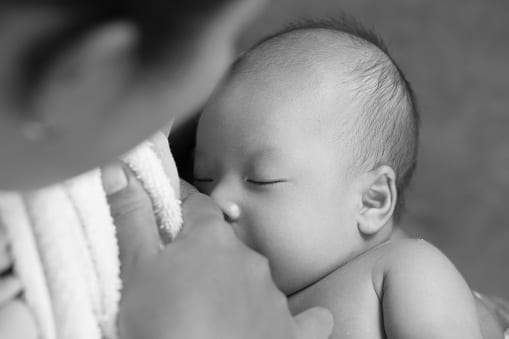How do you manage breastfeeding pains?
So you got off to a great start with baby, but now breastfeeding isn’t quite as comfortable as it used to be. Let’s take a closer look at what is normal, what is not, and how to treat and manage breastfeeding pains.
Sore nipples when nursing
Many moms experience soreness or pain in one or both nipples at some point with breastfeeding. Nipple soreness is often related to how well your baby is latching and maintaining a latched position during nursing.
Begin with by being in a comfortable position; help baby latch correctly. Don’t be shy about trying different positions with breastfeeding—what’s comfortable for you and baby both may change from day to day. Plus, changing positions with each feeding will give your baby different pressure points when sucking.
Having a bad latch is a common reason for nipple pain; this is cause by baby’s improper sucking. Some women may experience a wince of pain when nursing begins, but it should never last for more than a second or two.
To break baby’s latch, gently place your finger in baby’s mouth to break the suction. If your baby isn’t latched correctly, she’ll suck improperly causing painful nipples. Make sure your baby is opening her mouth wide enough, with her tongue down, and that she’s bringing the full nipple and a large part of the areola into her mouth. Until the soreness subsides, start the feeding on the least sore nipple and air-dry your breast after each feeding.
Promote pain relief and healing to sore, cracked, blistered or even bleeding nipples with the following proven strategies:
- Warm, moist compress or tea bags
- Breasts shells or shields go inside your bra when you’re not nursing. They let air circulate and keep your clothing from irritating your nipples
- Hydrogel pads in your bra between feedings create a soothing, moist healing
- You can also use purified lanolin on your nipples between and with each feeding; it helps your skin retain its moisture and protects it from further breakdown
- Massage a little of your milk into your nipples after each feeding to promote nipple health and help speed cure the nipple soreness
Talk to your nurse or baby’s healthcare provider if soreness and tenderness persist. You can also find a breastfeeding specialist (lactation consultant) through your healthcare providers.
If you simply need to give your nipples “time off” to heal, pump and feed baby breast milk from a bottle for 24-48 hours. Let dad or your partner help give baby pumped milk so that you can also rest and relax.
Too much milk
Your milk typically comes in around the 3rd-5th day after giving birth, depending on how often and effectively baby nurses in those first few days. You may find your breasts feel full and firm; this is normal.
The good news is that “your milk is in!” However, the discomfort (if any) is due to a combination of factors:
- hormonal changes
- increase in milk production
- increase of water, blood, and lymphatic fluid that helps prepare the breasts for feeding your baby
Frequent nursing will help reduce the fullness and discomfort. Typically, your areola remains soft and pliable and your newborn should be able to latch on without difficulty. Continue nursing and the fullness will decrease in about 24 hours. Take note: This does not mean your milk supply has diminished but that the swelling has.
Engorgement issues
Experiencing engorgement is different; it usually occurs as a result of receiving extra IV fluids during labor and birth. As the days and weeks of nursing roll by, you may also experience engorgement when your baby starts sleeping through the night for the first time and skips a feeding or two or when baby goes through a growth spurt and eats more frequently, stimulating your body to make more milk. Engorgement can also occur when you return to work or if you don’t have enough time to pump.
With engorgement, your breasts can feel firm, hard, lumpy, tender or painful—even the areola can be hard and taut. Your baby will struggle to latch on. Pumping some milk will assist in making the areola supple. These strategies will help you remedy or keep engorgement at bay:
- Feed your baby at least every 2 hours
- Cover both breasts with ice packs (or bags of frozen peas or corn that can be refrozen) in a “20-minute on, 45-minute off” rotation between feedings
- Place fresh, frozen washed cabbage leaves over the breasts for 15 to 20 minutes between feedings and repeat for 2 or 3 sessions. Skip this strategy if you’re allergic to cabbage or if a rash develops
- Take an anti-inflammatory like ibuprofen. Taking these medications right after nursing will reduce the chance they’ll reach baby.
- Use a warm compress before nursing to stimulate milk let-down; this is a good time to manually express a small amount of milk, leaving some on the nipple and areola to stimulate baby’s nursing
To help prevent engorgement, make sure your baby fully empties at least one breast during each nursing session. If baby leaves milk behind, you can pump it off to ensure your breasts remain soft and comfortable.
Plugged milk ducts
You may feel a swollen, tender spot in your breast and that could be a plugged milk duct. These happen when your baby isn’t taking enough milk out of your breasts. Using the same position for each feeding, wearing a tight or underwire bra or tight clothing can also cause plugged ducts.
This is one problem where a warm compress helps. Apply it gently to the area before a nursing session; you may want to also gently massage the area to get the milk moving again. Continue with frequent feedings, changing your position with each new feeding and try to spend some time not wearing a bra, or get fitted for the right-sized nursing bra or support top.
Breast infection
Mastitis begins as an inflamed milk duct and can develop into an infection. Mastitis can develop from plugged milk ducts or pores, sore or cracked nipples, not alternating breasts at each feeding, missed feedings, poor latch, not emptying the breasts at each feeding, or your own illness or stress.
Signs of mastitis include a hot, reddened area on the upper and outer part of one or both breasts. You will likely also have the sudden onset of fever, chills, body aches and a headache.
See your healthcare provider to treat mastitis; antibiotics are usually prescribed for 10-14 days, and you may want to take an anti-inflammatory like ibuprofen for pain and discomfort relief. You may find applying moist heat to your breasts before a feeding helps with discomfort. Always begin each feeding with the least painful breast. It’s important for you to rest when baby rests; continue with frequent feedings or pumping and use a warm compress before feedings.
Take care of yourself
You’re so busy taking care of baby, particularly in those first few weeks and months you may forget to also take care of yourself. It’s so important throughout your breastfeeding journey with baby you get rest when baby sleeps, drink plenty of fluids, eat a healthy, balanced diet, and ask for support from your partner, family, and friends.
Find a local breastfeeding support group and never hesitate to call your nurse or baby’s healthcare provider if you have any questions or concerns about nursing.
Related articles


Related video
How Will My Baby and I Begin Breastfeeding







Comments are closed.